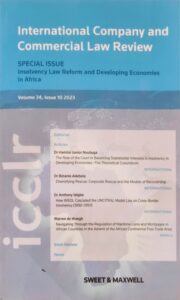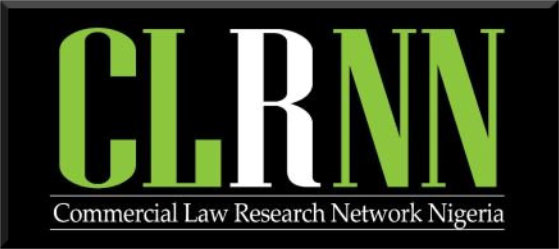by Anthony Idigbe SAN
Introduction
 The paper, which forms part of a broader study on the applicability of Finnemore and Sikkink’s norm life cycle theory to the evolution of the UNCITRAL Model Law on Cross-Border Insolvency (MLCBI), 1997, is at the intersection of insolvency and international relations. The motivation for the study stems partly from involvement with UNCITRAL Working Group V (WGV) as an observer from the Business Rescue and Insolvency Practitioners’ Association of Nigeria (BRIPAN), which is a Recognised Professional Body in Nigeria, and prolonged engagement with the annual INSOL/World Bank Africa Round Table. These engagements triggered an intrigue about the role of the International Association of Restructuring, Insolvency & Bankruptcy Professionals (INSOL), a non-state entity and global body of insolvency practitioners, in the making of the MLCBI. A further trigger for the study was the observation of a low adoption rate of the MLCBI amongst emerging economies.
The paper, which forms part of a broader study on the applicability of Finnemore and Sikkink’s norm life cycle theory to the evolution of the UNCITRAL Model Law on Cross-Border Insolvency (MLCBI), 1997, is at the intersection of insolvency and international relations. The motivation for the study stems partly from involvement with UNCITRAL Working Group V (WGV) as an observer from the Business Rescue and Insolvency Practitioners’ Association of Nigeria (BRIPAN), which is a Recognised Professional Body in Nigeria, and prolonged engagement with the annual INSOL/World Bank Africa Round Table. These engagements triggered an intrigue about the role of the International Association of Restructuring, Insolvency & Bankruptcy Professionals (INSOL), a non-state entity and global body of insolvency practitioners, in the making of the MLCBI. A further trigger for the study was the observation of a low adoption rate of the MLCBI amongst emerging economies.
The norm life cycle theory from international relations became the prism for observing actors’ actions in evolving global insolvency norms. The life cycle approach postulates three stages in norm evolution: norm emergence, norm cascade, and norm internalization. A prior paper addresses why INSOL was formed and became the norm entrepreneur for cooperation and coordination among state courts in cross-border insolvency. This paper considers the cascade of the MLCBI, which is at the second stage of the norm life cycle.
Why Regulate Cross-border Insolvency?
When a multinational enterprise group (MEG) such as Nortel, Parmalat or Lehman Brothers fails, it has an impact beyond a single state as creditors and other stakeholders outside its territory or jurisdiction or Center of Main Interest (COMI) are affected. For example, at the point of its collapse, Nortel Network Corporation, a Canadian multinational enterprise group, had 143 subsidiaries in over 100 countries with 93,000 employees generating annual revenue of $30 billion US dollars and a market capitalization of $250 million US dollars. Recently, Apple hit a market capitalization of $2 Trillion US dollars. This is larger than the GDP of the 54 African countries.
Given the presence of assets and creditors across jurisdictions, differing laws may apply. It is therefore important to have legal processes for dealing with theses situations for the benefit of all stakeholders, as well as to maximise the value in such estates. However, before 1997, the bankruptcy laws of different states treated creditors and stakeholders differently, applying local laws to domestic insolvency. These domestic laws differed in their features and principles and limited in their extra-territorial reach. So, before 1997, when the MLCBI was adopted, insolvency practitioners, their creditors, and even debtors seeking restructuring solutions were left with uncertain legal outcomes, frustration, and hardship.
These motivated individual practitioners to organize themselves into INSOL, a federation of insolvency practitioners. However, the norm making space was already occupied by the International Bar Association (IBA) whose Committee J was focused on harmonization through their Model International Insolvency Cooperation Act (MIICA) after many years of collaborating with the American Bar Association (ABA) International Committee. In contrast, INSOL generated two crucial norms of cooperation and coordination to resolve the challenge of cross-border insolvency among practitioners and later State Courts, thus meeting the first stage of the norm life cycle: Norm Emergence. The analysis that follows provides key insights into how INSOL cascaded its norms in the face of pre-existing IBA norms and State domination of norm-making in international law. It draws from archival and empirical data obtained through semi-structured interviews.
From Norm Emergence to Norm Cascade
Free trade ideology promotes a universal solution by way of harmonization through a treaty or convention solution of one forum and one law for the management of insolvency and bankruptcy wherever the assets may be located. This approach was espoused by the United States, which pushed its agenda for a bankruptcy convention at the International Chamber of Commerce (ICC) Annual Conferences. For example, the US Delegation to the Third ICC Congress of 1925 supported a resolution for a convention on bankruptcy. Also, in 1939, the US Delegation to the ICC Congress voted for a resolution urging the conclusion of bilateral bankruptcy treaties. It later supported the creation of United National Committee on International Trade Law (UNCITRAL) in 1966 in what Edward Cohen calls forum shifting from Eurocentric normative modelling sites like The Hague Conference and the International Institute for the Unification of Private Law (UNDROIT). UNCITRAL also enabled the shift away from postcolonial State-centric sites like the UN General Assembly. UNCITRAL is now the neo-liberal site for harmonizing and modernizing international trade laws. To achieve its objectives norm leader, the US, initially supported the International Bar Association proposal of the Model International Insolvency Cooperation Act (MIICA) for a harmonized convention on insolvency based on universalism, single forum, and single choice of law.
However, having tracked norm definition between 1982 and 1997, the paper finds that contestation over the norm that would prevail over cross-border insolvency was dynamic. Many norm entrepreneurs and leaders changed their definitions. The US and even IBA shifted their positions on acceptable norms, moving from reciprocal harmonization to limited cooperation and coordination among state courts proposed by INSOL. The paper sets out how INSOL achieved this feat by applying persuasion techniques, which involved knowledge leadership, improved membership drive among norm leaders, organization and conferences, engagement with UNCITRAL, facilitation of communication among judges of different states, secrecy to manage backlash in norm contestation process, and others.
Findings and Concluding Thoughts
The paper finds that the MLCBI emerged because many delegates, including US and IBA delegates, changed their position on norm definition from the MIICA approach to the Model Law approach. The Model Law approach was directly an INSOL contribution, and this conclusion is supported by the Ron Harmer Report, as well as the Judges’ Summation, and confirmed by the Introduction Document at UNCITRAL WGV.
The change in approach is attributable to the persuasive techniques of INSOL. The norm dynamics over the negotiation period were open and inclusive within the set limits. Interview subjects, including IBA representatives, indicated that although INSOL was an observer, State delegates treated their contribution as authoritative. The interview subjects indicated that INSOL was more focused on insolvency, unlike IBA, so it was easier for it to provide the required leadership. Conversely, the IBA representative indicated that his frequent reports on proceedings of WGV to IBA Committee J did not receive timely responses. Moreover, INSOL committed its resources to its collaboration with UNCITRAL, aided by Group 36, which also made a difference in their success.
INSOL’s persuasion technique was strategic. It was not as combative as is often found in the international human rights arena. It applied the Chatham House rule and focused its efforts on norm leader, which meant every effort to persuade and involve US state delegates and observers who were more familiar with s.304 of the US Bankruptcy Code for a uniform insolvency system and had a history of supporting uniform convention and treaty solution. It succeeded. Thus, their greatest champions became the US delegates and observers who persuaded other norm followers. The life cycle approach played out entirely.
The demonstrates that the life cycle approach is applicable to explain the success of INSOL in cascading the norm of cooperation and coordination at UNCITRAL through the adoption of the Model Law approach. Moreover, that the balance between the participation of State and Non-state entities in UNCITRAL and its output improves UNCITRAL’s legitimacy and accountability.
For the full paper: A. Idigbe, ‘How INSOL Cascaded the UNCITRAL Model Law on Cross-Border Insolvency’ (1992 – 1997) [2023] 34 ICCLR
Dr Anthony Idigbe SAN is the Senior Partner at PUNUKA Attorneys & Solicitors. He has over 39 years of experience in International Commercial Law. His doctorate dissertation at Osgoode Hall Law School, York University, Toronto, Ontario, Canada was titled: Norm Life Cycle Theory and the role of INSOL International in shaping the 1997 UNCITRAL Model Law on Cross-Border Insolvency. He is available at a.idigbe@punuka.com.

